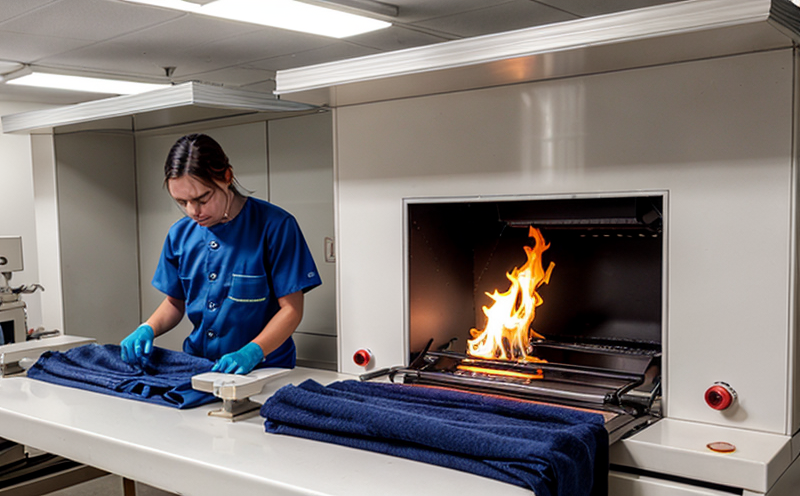Reaction-to-Fire Testing of Nonwoven Fabrics
The reaction-to-fire testing of nonwoven fabrics is a critical process in ensuring that materials meet rigorous safety standards and are suitable for use in environments where flammability can pose significant risks. This service focuses on evaluating the ignition behavior, flame spread, heat release rate, smoke production, and other fire-related properties of nonwovens under controlled conditions.
Nonwoven fabrics encompass a wide range of materials including spunbonded, meltblown, and composite structures, each with unique physical and chemical properties. These materials are used in various applications such as filtration systems, medical textiles, personal protective equipment (PPE), automotive components, and insulation products. The fire safety testing ensures that these materials do not ignite easily or spread flames rapidly when exposed to heat sources.
Our laboratory uses state-of-the-art facilities equipped with advanced instrumentation like cone calorimeters, oxygen index testers, and vertical flame testers. These tools allow us to conduct comprehensive tests according to international standards such as ASTM E648, ISO 5267-1, and EN 379. We employ experienced technicians who follow strict protocols to prepare specimens, control environmental conditions, and analyze results.
Preparation of the test samples involves cutting uniform pieces from larger rolls or sheets according to specified dimensions required by the standard being followed. Specimens are conditioned in a controlled atmosphere chamber at specific humidity levels and temperatures before testing begins. During testing, we monitor various parameters including peak heat release rate (PHRR), mass loss, smoke density, and char depth.
The data collected from these tests is then analyzed using statistical methods to determine compliance with regulatory requirements or company specifications. Reports detailing test procedures, equipment used, observed results, and conclusions are provided promptly after completion of each project. Our clients rely on our expertise in interpreting these reports so they can make informed decisions about product design improvements or material selection.
In summary, reaction-to-fire testing plays a vital role in safeguarding lives by preventing fires caused by nonwoven materials used in manufacturing processes across many industries. By providing accurate and reliable test results based on sound scientific principles, our laboratory helps ensure that products meet necessary safety standards while also maintaining high performance levels.
Why It Matters
The importance of reaction-to-fire testing cannot be overstated given the potential consequences associated with poorly designed or manufactured nonwoven fabrics. When exposed to fire, materials that do not meet appropriate flammability limits can contribute significantly to rapid spread of flames and toxic smoke emissions.
- Increased risk of injury or death in case of accidental ignition
- Higher insurance premiums for businesses operating facilities where nonwovens are used extensively
- Potential recalls and product liability issues if a defective material enters the market
- Economic losses due to property damage caused by fires ignited by flammable materials
Conducting thorough reaction-to-fire tests allows manufacturers and suppliers to identify any shortcomings early in the development process, enabling them to address these issues before products reach end users. Additionally, compliance with regulatory requirements enhances brand reputation and fosters trust among consumers who value safety above all else.
Industry Applications
The results of reaction-to-fire tests are applicable across numerous sectors including healthcare, automotive manufacturing, construction, military applications, and consumer goods. Below is a table highlighting some key areas where this type of testing proves beneficial:
| Sector | Application | Reason for Testing |
|---|---|---|
| Healthcare | Making PPE like gowns and masks safer | To ensure they won't catch fire easily or melt when exposed to heat sources. |
| Automotive | Designing seat covers, headliners, carpets | Avoiding interior fires that could lead to accidents. |
| Construction | Manufacturing insulation materials used in buildings | To prevent accidental ignition from electrical faults or open flames. |
| Military | Creating protective gear for soldiers | Ensuring protection against both physical hazards and fire risks. |
| Consumer Goods | Producing bedding, clothing items | To protect consumers from potential burns or respiratory issues caused by smoke inhalation during fires. |
In addition to the table above, here are some specific examples of how reaction-to-fire testing impacts different industries:
- Healthcare: Hospitals must comply with stringent regulations regarding fire safety. Nonwoven fabrics used in surgical gowns and masks need rigorous testing to ensure they will not catch alight or melt when exposed to heat sources.
- Automotive: Car manufacturers use nonwovens for seat covers, headliners, carpets, etc., which should be flame retardant so as not to contribute towards rapid spread of flames in case of a fire inside the vehicle.
- Construction: Builders often incorporate nonwoven insulation materials into walls and ceilings. These materials need to pass strict flammability tests to prevent accidental ignition from electrical faults or open flames.
- Military: Soldiers depend on protective clothing made from nonwovens that are both flame retardant and robust enough to withstand harsh conditions. Proper reaction-to-fire testing ensures these garments provide adequate protection against fire hazards.
International Acceptance and Recognition
The importance of adhering to internationally recognized standards cannot be overstated when it comes to ensuring the highest quality and consistency in reaction-to-fire testing services. Our laboratory conforms strictly to global guidelines set forth by organizations such as ASTM International, ISO, IEC, and EN.
- ASTM E648 - Standard Test Method for Heat Release Rate of Textiles Using a Cone Calorimeter
- ISO 5267-1 - Determination of Flame Retardancy of Textile Fabrics - Part 1: Vertical Test
- EN 379 - Specification for Flame Resistant Clothing
- IEC TR 62804 - Fire Safety Engineering of Electrical and Electronic Products in the Home, Office and Other Similar Environments
Beyond just following these standards, we also stay updated on emerging trends and best practices within the industry to ensure our testing remains current and relevant. This commitment to excellence means that our clients can trust us to deliver accurate results no matter what part of the world they operate in.





